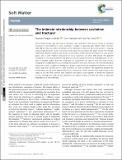The intimate relationship between cavitation and fracture
Author(s)
Raayai Ardakani, Shabnam; Earl, Darla; Cohen, Tal
Downloadc9sm00570f.pdf (2.242Mb)
Terms of use
Metadata
Show full item recordAbstract
Nearly three decades ago, the field of mechanics was cautioned of the obscure nature of cavitation processes in soft materials [A. Gent, Cavitation in rubber: a cautionary tale, Rubber Chem. Technol., 1990, 63, 49–53]. Since then, the debate on the mechanisms that drive this failure process is ongoing. Using a high precision volume controlled cavity expansion procedure, this paper reveals the intimate relationship between cavitation and fracture. Combining a Griffith inspired formulation for crack propagation, and a Gent inspired formulation for cavity expansion, we show that despite the apparent complexity of the fracture patterns, the pressure–volume response follows a predictable path. In contrast to available studies, both the model and our experiments are able to track the entire process including the unstable branch, by controlling the volume of the cavity. Moreover, this minimal theoretical framework is able to explain the ambiguity in previous experiments by revealing the presence of metastable states that can lead to first order transitions at onset of fracture. The agreement between the simple theory and all of the experimental results conducted in PDMS samples with shear moduli in the range of 25–246 [kPa] confirms that cavitation and fracture work together in driving the expansion process. Through this study we also determine the fracture energy of PDMS and show its significant dependence on strain stiffening.
Date issued
2019-05Department
Massachusetts Institute of Technology. Department of Civil and Environmental Engineering; Massachusetts Institute of Technology. Department of Mechanical EngineeringJournal
Soft Matter
Publisher
Royal Society of Chemistry (RSC)
Citation
Raayai-Ardakani, Shabnam et al. "The intimate relationship between cavitation and fracture." Soft Matter 15, 25 (July 2019): 4991–5176 © 2019 Royal Society of Chemistry
Version: Final published version
ISSN
1744-683X
1744-6848